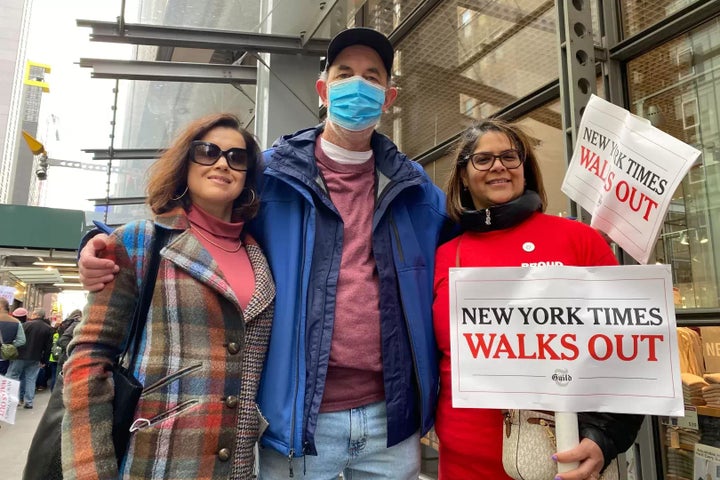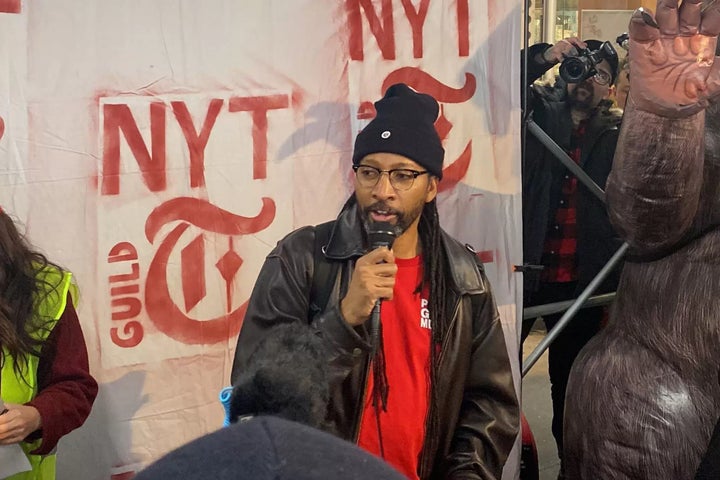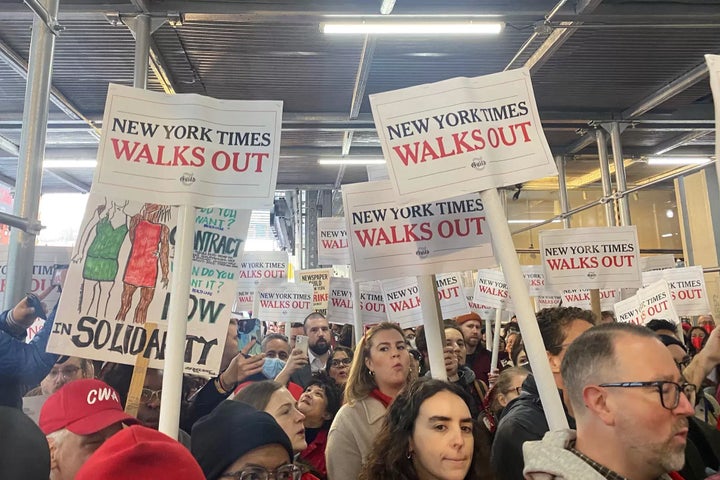The Other New York Times Workers On Strike
Claudia Irizarry Aponte— THE CITY
Dec 8, 2022

Security workers Karen Letellier, left, John Garafalo and Lila Rivera were among the 1,100 employees of The New York Times who walked off the job for 24 hours, Dec. 8, 2022.
CLAUDIA IRIZARRY APONTE/THE CITY
When a man wielding a sword and an axe entered the New York Times building last month and demanded to speak with a reporter, it was security workers, among them Karen Letellier, who confronted him, ordering him to surrender his bag and drop to the ground.
“Our job is a huge responsibility,” said Letellier, 36, a concierge who has worked for the Times for five years. “There is no room for mistakes when people’s lives are at risk.”
Letellier, like other security workers, is also one of the lowest-earning employees at The New York Times. She is among the nearly 1,100 New York Times Guild members who walked off the job for 24 hours at midnight Thursday. They’re part of a union that includes reporters, editors and assistants, but also lower-wage workers like security guards, IT specialists, ushers and sales coordinators who earn as little as $52,000 annually.
They, like all the Times staffers on strike, contend they’ve lost out on the Gray Lady’s boom of recent years. One of the few profitable media companies in the country, it reported a $36.6 million profit in the third quarter and an operating profit of $51 million, up from $49 million the previous year, even as it spent $550 million to purchase the sports news website The Athletic, and an undisclosed amount in “the low seven figures” range for the Wordle game app this year.
Among the union demands still on the table: Increasing the salary floor to $65,000, which the company has so far refused even as it authorized $150 million in stock buybacks this year.
The union estimates the proposals would cost the company roughly $100 million over the four-year life of the contract. Management and the union have been bargaining for 20 months, ever since the contract spanning roughly 1,400 staffers expired in March 2021.

Security workers Karen Letellier, left, John Garafalo and Lila Rivera were among the 1,100 employees of The New York Times who walked off the job for 24 hours, Dec. 8, 2022.
CLAUDIA IRIZARRY APONTE/THE CITY
When a man wielding a sword and an axe entered the New York Times building last month and demanded to speak with a reporter, it was security workers, among them Karen Letellier, who confronted him, ordering him to surrender his bag and drop to the ground.
“Our job is a huge responsibility,” said Letellier, 36, a concierge who has worked for the Times for five years. “There is no room for mistakes when people’s lives are at risk.”
Letellier, like other security workers, is also one of the lowest-earning employees at The New York Times. She is among the nearly 1,100 New York Times Guild members who walked off the job for 24 hours at midnight Thursday. They’re part of a union that includes reporters, editors and assistants, but also lower-wage workers like security guards, IT specialists, ushers and sales coordinators who earn as little as $52,000 annually.
They, like all the Times staffers on strike, contend they’ve lost out on the Gray Lady’s boom of recent years. One of the few profitable media companies in the country, it reported a $36.6 million profit in the third quarter and an operating profit of $51 million, up from $49 million the previous year, even as it spent $550 million to purchase the sports news website The Athletic, and an undisclosed amount in “the low seven figures” range for the Wordle game app this year.
Among the union demands still on the table: Increasing the salary floor to $65,000, which the company has so far refused even as it authorized $150 million in stock buybacks this year.
The union estimates the proposals would cost the company roughly $100 million over the four-year life of the contract. Management and the union have been bargaining for 20 months, ever since the contract spanning roughly 1,400 staffers expired in March 2021.

Bill Baker, a unit chair and IT specialist at The New York Times, speaks at the picket line on Thursday.
CLAUDIA IRIZARRY APONTE/THE CITY
Many workers have not received any merit or negotiated increase, aside from contractual raises, in more than a decade, said Bill Baker, an IT specialist at the Times company for 16 years. Many in his department earn annual salaries in the range of $55,000, Baker said.
“There has been no real upward mobility for people in my department” other than being promoted to non-union positions, he said.
‘We Deserve It’
The work stoppage, the likes of which has not been seen at the Times in decades, left several major desks without staff. The last major Guild-led work stoppage at the scale of Thursday’s strike was a multiday strike in September and October of 1965. In 2017, Times staffers staged a brief lunchtime walkout to protest planned cuts to the newsroom’s copyediting staff.
The union currently includes reporters, editors and research and news assistants across the country, plus security personnel and workers on the business side — including the IT, finance and advertising departments — who are employed by the company in its headquarters on Eighth Avenue near Times Square.
While much of the public’s attention has focused on the Times’ reporters and editors, who make up the bulk of the bargaining unit, union activists are conscious that the most pressing needs are felt by administrative staff.
“We’re representing people with such varied jobs and interests, so this can be a chance for us to make sure we’re covering all those bases and a big part of our ask this time around,” said grievance chair Jim Luttrell, a senior editor.
“We’re not being greedy. We deserve it,” said concierge Lila Rivera, 49, of the union’s demand for a $65,000 salary floor. “It’s our responsibility to make this place safe.”
Workers at The New York Times have been represented by the NewsGuild of New York since 1940. The unit has historically included security guards, sales coordinators and customer service representatives alongside reporters and editors.
In previous decades, the unit also included cafeteria workers and building management at the Times’ old headquarters before those positions were outsourced, said Baker, who is a unit chair.
A separate unit representing some 700 tech workers — engineers and designers who manage the website interface and its news apps — voted to unionize with the NewsGuild of New York this year. Those employees staged a “collective lunch break” in solidarity with their striking coworkers on Thursday.
Seeing Red
Scores of Times workers — wearing red clothing, the NewsGuild’s color — attended an afternoon rally in front of the newspaper’s headquarters near Times Square.
Among the speakers was Pulitzer Prize-winning reporter Nikole Hannah-Jones, a unit council member.
“When this paper struggled, all of us had to share in its austerity,” said Hannah-Jones. “When this paper is doing well, the people who work hard every day to make this place a global phenomenon deserve to share in success.”

Hundreds of reporters and workers of The New York Times formed a picket line outside their Times Square building as contract negations stalled.
CLAUDIA IRIZARRY APONTE/THE CITY
No labor action has stopped production of the paper since the New York City newspaper strike of 1978, which halted the print and distribution of several newspapers in the region, including The New York Times, for 88 days.
“It is disappointing that they are taking such an extreme action when we are not at an impasse,” New York Times spokesperson Danielle Rhoades Ha said in a statement. “Though we’ve made progress and offered several new proposals this week to address issues identified as priorities by the Guild, we still have much more work to do when we return to the bargaining table.”
Throughout Thursday, the Times was publishing and sharing stories across social platforms and its mobile app, including a news alert for WNBA star Brittney Griner’s release from a Russian prison in a prisoner swap.
The company began planning for the work stoppage last week, asking reporters to file stories early as if preparing for a major holiday, and using additional resources like its non-union international staff. Times management ramped up its efforts following more than 1,100 union members signing a pledge to walk out of the job on Thursday if the two sides did not reach an agreement.
By Wednesday, the company backed off a proposal to replace its existing adjustable pension plan with a 401(k) retirement plan, instead letting the union choose between the two, the Associated Press reported. The company also agreed to expand fertility treatment benefits.
Workers on the picket line said the decision to go on strike was not easy, nor one they were eager to make.
“But we need more money, we need job security,” said security guard John Garafalo, gesturing at the scores of Times workers picketing on 40th Street. “These are my people.”
THE CITY is an independent, nonprofit news outlet dedicated to hard-hitting reporting that serves the people of New York.
“It is disappointing that they are taking such an extreme action when we are not at an impasse,” New York Times spokesperson Danielle Rhoades Ha said in a statement. “Though we’ve made progress and offered several new proposals this week to address issues identified as priorities by the Guild, we still have much more work to do when we return to the bargaining table.”
Throughout Thursday, the Times was publishing and sharing stories across social platforms and its mobile app, including a news alert for WNBA star Brittney Griner’s release from a Russian prison in a prisoner swap.
The company began planning for the work stoppage last week, asking reporters to file stories early as if preparing for a major holiday, and using additional resources like its non-union international staff. Times management ramped up its efforts following more than 1,100 union members signing a pledge to walk out of the job on Thursday if the two sides did not reach an agreement.
By Wednesday, the company backed off a proposal to replace its existing adjustable pension plan with a 401(k) retirement plan, instead letting the union choose between the two, the Associated Press reported. The company also agreed to expand fertility treatment benefits.
Workers on the picket line said the decision to go on strike was not easy, nor one they were eager to make.
“But we need more money, we need job security,” said security guard John Garafalo, gesturing at the scores of Times workers picketing on 40th Street. “These are my people.”
THE CITY is an independent, nonprofit news outlet dedicated to hard-hitting reporting that serves the people of New York.
No comments:
Post a Comment